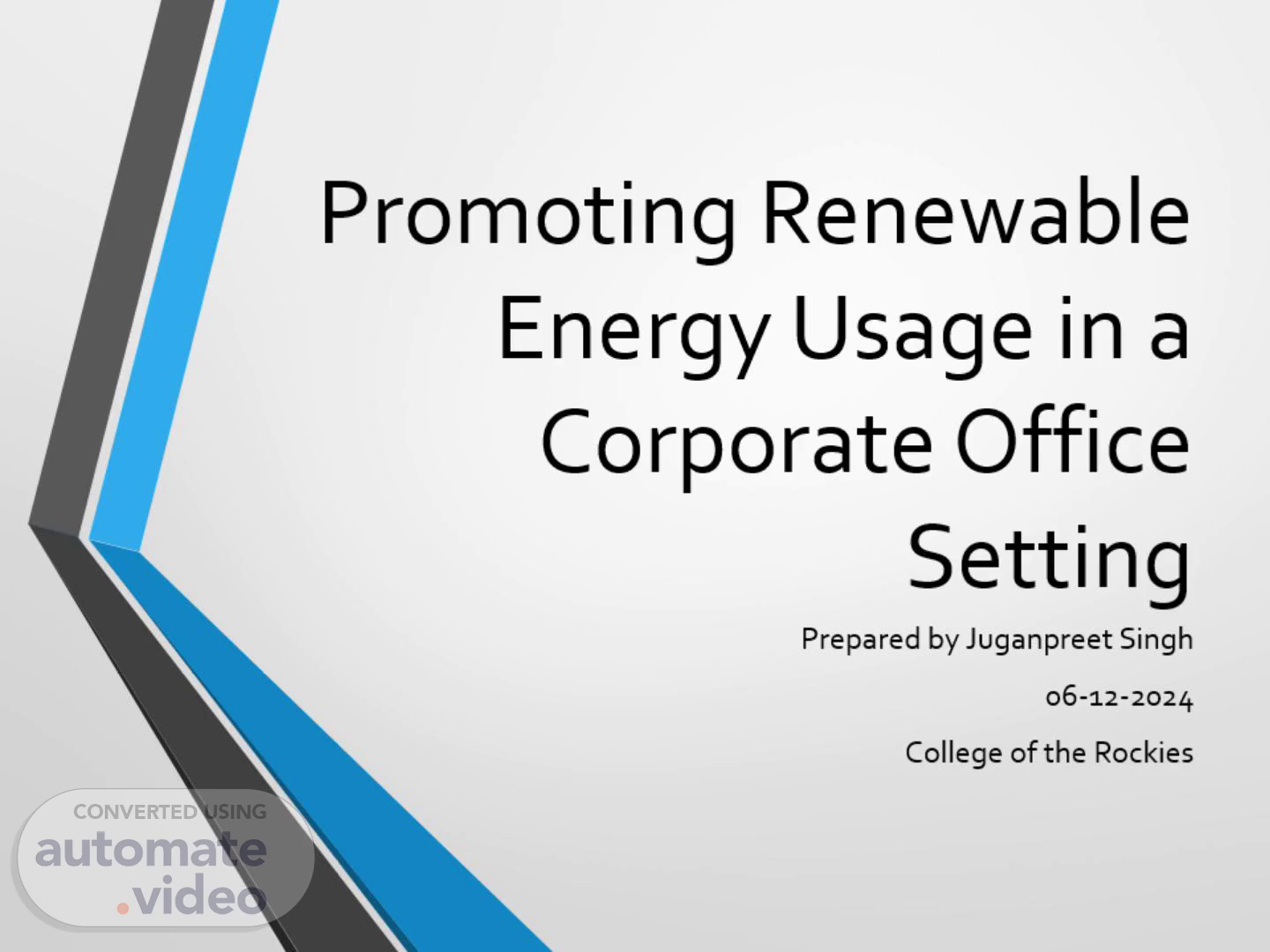
Promoting Renewable Energy Usage in a Corporate Office Setting
Scene 1 (0s)
[Audio] "Welcome to this presentation on Promoting Renewable Energy Usage in a Corporate Office Setting. I’m Juganpreet Singh , and today I’ll walk you through a comprehensive sustainability plan that addresses environmental, financial, and social goals by transitioning corporate energy usage to renewable sources.".
Scene 2 (4m 56s)
[Audio] "In corporate offices, energy consumption heavily relies on non renewable sources, contributing to greenhouse gas emissions and environmental degradation. This initiative focuses on transitioning to renewable energy like solar and wind while improving energy efficiency. By doing so, we align with corporate social responsibility goals and set an example for sustainable practices.".
Scene 3 (9m 56s)
[Audio] “The initiative has three primary goals: Environmental preservation by reducing the office’s carbon footprint. Financial savings through reduced energy costs over time. Enhancing social responsibility, strengthening organizational reputation, and engaging employees in sustainability efforts.".
Scene 4 (10m 16s)
[Audio] "Why act now? Climate change urgency and rising energy costs demand immediate action. Governments offer incentives for renewable energy adoption, and renewable technologies have become more affordable. This initiative aligns with corporate values, enhancing operational efficiency while demonstrating leadership in environmental stewardship.".
Scene 5 (10m 36s)
[Audio] "Our six step action plan ensures effective implementation: First, conduct energy audits to identify inefficiencies and set a baseline for improvement..
Scene 6 (10m 48s)
[Audio] Second, collaborate with renewable energy providers to source solar or wind power..
Scene 7 (10m 56s)
[Audio] Third, upgrade office infrastructure with energy efficient systems like L-E-D lighting and smart thermostats..
Scene 8 (11m 5s)
[Audio] Fourth, install renewable energy systems such as solar panels or procure renewable energy certificates..
Scene 9 (11m 13s)
[Audio] Fifth, engage employees through workshops and campaigns to promote energy saving habits like turning off unused devices..
Scene 10 (11m 21s)
[Audio] Lastly, monitor and evaluate the initiative’s impact through periodic audits and employee feedback, continuously refining strategies for improvement.".
Scene 11 (11m 30s)
[Audio] "Leadership plays a pivotal role in driving this initiative. A transformational leadership style is essential to inspire innovation and motivate employees.”.
Scene 12 (11m 40s)
[Audio] “Leaders must actively demonstrate their commitment, engage employees through transparent communication, and recognize contributions. Effective leadership ensures buy in from all stakeholders.".
Scene 13 (11m 52s)
[Audio] "Stakeholder collaboration is critical. Internally, employees, management, and sustainability committees must align their efforts. Externally, partnerships with renewable energy providers, consultants, and local governments provide technical expertise, financial incentives, and support for a seamless transition.".
Scene 14 (12m 12s)
[Audio] "Change management is key to overcoming barriers. Financial constraints can be mitigated with phased implementation and grants. Resistance to change is minimized through transparent communication and employee involvement..
Scene 15 (12m 25s)
[Audio] Building a sustainability focused culture requires leadership setting an example and celebrating milestones. Norms are reinforced through gamification and team challenges, creating excitement and participation.".
Scene 16 (12m 39s)
[Audio] "Technology is an enabler. Energy management systems provide real time monitoring and actionable insights. Gamification tools further engage employees by making energy saving efforts fun and rewarding. These tools ensure continuous progress and keep employees motivated.".
Scene 17 (12m 58s)
[Audio] "Clear role definitions are vital for accountability. Renewable energy goals should be integrated into performance reviews, making sustainability a key success metric. Regular check ins with team leads ensure adherence and address challenges promptly.".
Scene 18 (13m 13s)
[Audio] "The outcomes of this initiative are significant. In the short term, reduced energy costs and increased awareness among employees are expected. Long term benefits include achieving carbon neutrality, enhancing organizational reputation, and inspiring similar actions within the community.".
Scene 19 (13m 31s)
[Audio] "Continuous improvement is critical. Regular energy audits and feedback sessions help refine strategies. Celebrating achievements sustains momentum, while fostering a culture of innovation ensures long term success. This approach embeds sustainability into the organization’s operations.".
Scene 20 (13m 49s)
[Audio] "In conclusion, promoting renewable energy in corporate offices addresses the pressing issue of climate change while achieving operational and social goals. Leadership, collaboration, and innovation are the pillars of success. Let’s lead the way in creating a sustainable future.".
Scene 21 (14m 5s)
References. Bass, B. M., & Riggio, R. E. (2006). Transformational leadership. Psychology Press. Carter, J., & Hughes, R. (2020). Leadership and sustainability integration: A strategic perspective. Journal of Organizational Change, 17(4), 223-245. International Energy Agency. (2022). Renewable energy: Accelerating the transition to clean energy. Retrieved from https://www.iea.org.
Scene 22 (14m 26s)
References. Jones, T., & Brown, P. (2019). Sustainable business strategies: Integrating CSR and environmental goals. Greenleaf Publishing. Smith, J., Taylor, L., & Davis, R. (2020). Energy efficiency in corporate settings: Challenges and opportunities. Journal of Sustainable Energy Practices, 12(3), 45-59. Taylor, S., & Green, M. (2021). Gamification and employee engagement in sustainability initiatives. Corporate Social Responsibility Journal, 18(2), 123-135..